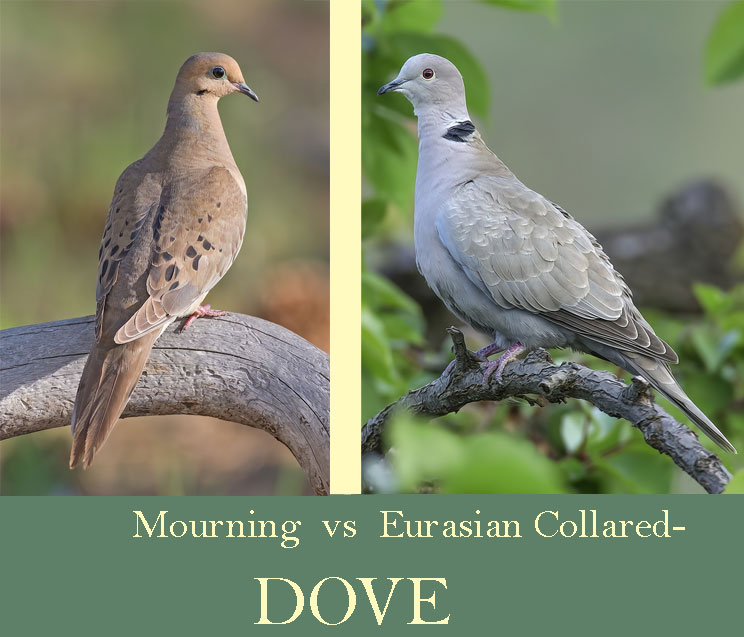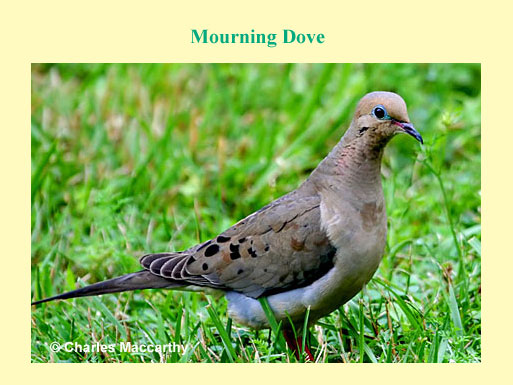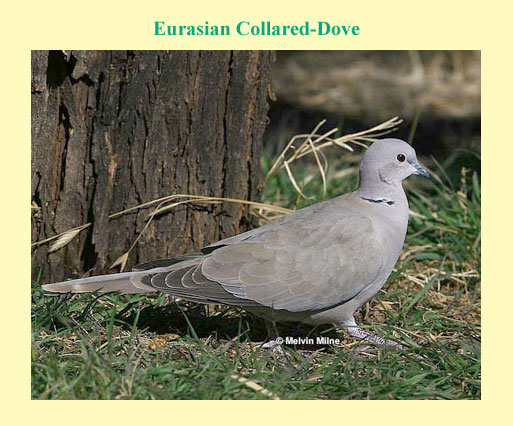
Mourning Doves and Eurasian Collared-Doves are two of the most common dove species in North America. They are found in similar habitats, and the fact that they look really similar does not help the identification process.
So how to tell them apart? Keep reading to find out!
On this page
Mourning Dove

Note the blue eye ring, bill size and black spots on the wings of this Mourning Dove.
The Mourning Dove is our most widespread and common dove. This pale brown and gray dove species is common in parks and will build their rough nest in hanging flower parts or other backyard locations.
Mourning Doves are darker in color and have darker patches on their wings, while Eurasian Collared Doves are much lighter in color and do not have many markings on their wings.
In recent years, the introduced Eurasian Collared-Dove, below, has spread rapidly across the United States.
Eurasian Collared-Dove

The Eurasian Collared-Dove has the same general shape and color of the Mourning Dove. Note the small bill, lack of blue eye ring, black mark on neck and plain gray color on wings. Larger than the Mourning Dove. They also have a lot more white in their rectangular tail.
The “collar,” which they are named after is a great identification indicator as well. The African Collared Dove has a similar neck ring, but they are rarely spotted.
The diets of these two birds are quite similar, but Mourning Doves rely more heavily on seeds. Meanwhile, Eurasian Collared-Doves eat mostly seeds too, but they turn to insects more often.
In recent years, the introduced Eurasian Collared-Dove, below, has spread rapidly across the United States. These species can often be found together.
Key differences between Mourning Doves and Eurasian Collared-Doves
The Mourning Dove and Eurasian Collared-Dove are two species of doves that often give great ID challenges. Here are some key differences between the two:
- Eurasian Collared-Doves are larger than Mourning Doves, with an overall length of 12-14 inches compared to the Mourning Dove’s 9-13 inches.
- Mourning Doves have a light gray-brown head, neck, and body with black spots on their wings and a long, pointed tail. Eurasian Collared-Doves have a light gray-brown head, neck, and body, but they have a distinctive black collar on the back of their neck and a shorter, square-shaped tail.
- Mourning Doves are native to North America and can be found throughout the continent, while Eurasian Collared-Doves are native to Europe and Asia and have been introduced to North America, where they are now established in most of North America (most of the United States, except for some eastern areas, Mexico and southern Canada).
- Mourning Doves are found in a wide variety of habitats, including urban areas, forests, fields, and deserts. Eurasian Collared-Doves are also adaptable and can be found in urban and suburban areas, as well as agricultural fields and open woodlands.
- The Mourning Dove’s call is a distinctive, mournful cooing sound, often described as “coo-OO-oo-oo”. The Eurasian Collared-Dove’s call is similar to the Mourning Dove’s but is typically shorter and less mournful, with a more abrupt ending.

